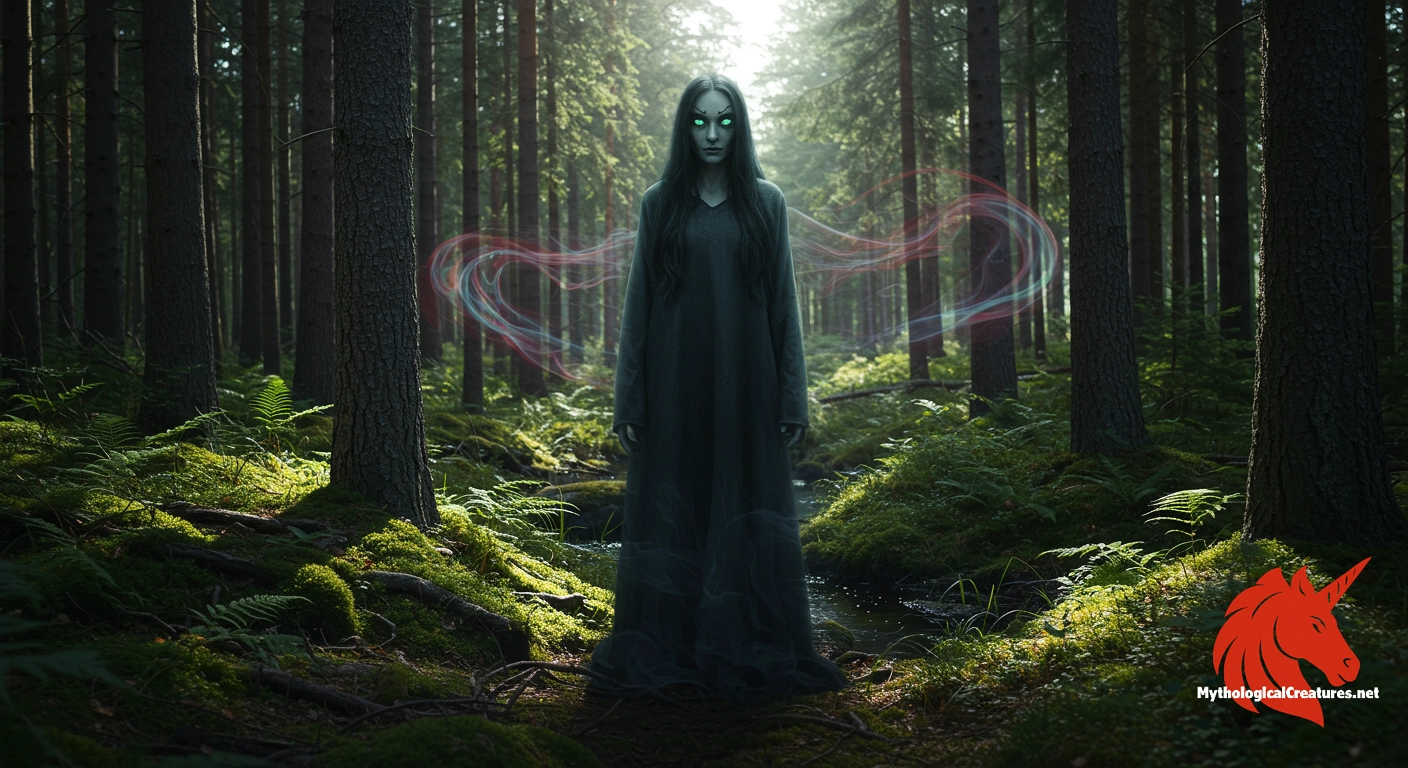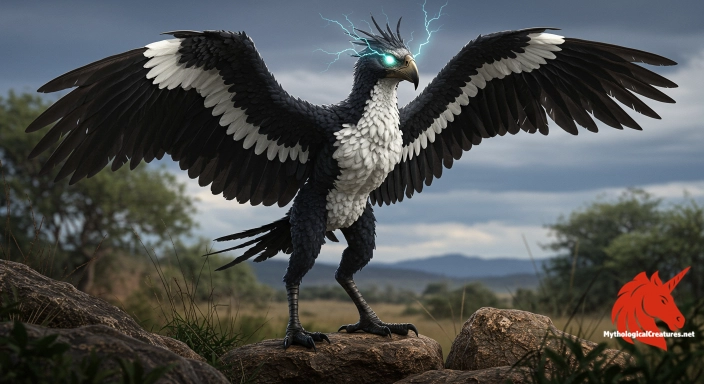Ajatar: Ajatar is an evil female spirit from Finnish folklore.

Ajatar
Ajatar - Ajatar embodies the dark and malevolent forces in Finnish myth, serving as a cautionary figure within the folklore.
Origins & First Encounters
Ajatar is a legendary female spirit deeply woven into the fabric of Finnish folklore, embodying an aura of malevolence and unbridled natural forces. Born from a time when the boundaries between the spiritual and earthly realms were indistinct, she emerged as a personification of chaos and shadow. Her origins are shrouded in the mists of ancient pagan belief, where natural phenomena were often explained by the caprices of supernatural beings. Early oral traditions hint at her existence long before the arrival of written records, making her one of the more enigmatic figures of Finnish myth. Over the years, her name has taken on multiple forms—Ajattara, Aiätär, and Aijotar—each variation underscoring different facets of her dark persona. Local communities embraced her as a symbol of ominous change, often invoking her spirit to explain inexplicable calamities. Her narrative is interlaced with themes of forbidden power and nature’s fury, reflecting deep-seated cultural fears. The shifting seasons and harsh northern winters further amplified her image as a bringer of misfortune and despair. Throughout the annals of folklore, she has remained a steadfast reminder of humanity’s fragile control over the forces of nature. In a cultural landscape rich with myth, Ajatar stands out as a timeless emblem of the contentious interplay between beauty and terror.
Source Texts & Tale Variants
Though Ajatar is sparsely documented in the earliest manuscripts, her legend has been robustly maintained through centuries of oral storytelling. Early folkloric accounts, collected by dedicated seers and local storytellers, offered veiled references that hinted at her malevolent influence. Over time, these narratives accumulated into a mosaic of tales, each variant lending new layers to her character. Some versions credit her with emanating from the remnants of ancient spiritual conflicts, while others portray her as a primordial force born from the earth’s darker impulses. In folkloric anthologies compiled during the 19th and early 20th centuries, her story was interwoven with folk songs and ritualistic warnings. Varied recensions capture her as a spectral presence haunting remote forests and lonely marshlands. The diverse story variants reveal subtle differences in her motivations and methods, reflecting regional anxieties and the unpredictable temperament of nature. Although not as elaborately chronicled as some of her counterparts, the fragments of her tale have served as a vital reservoir for understanding Finnish mythic paradigms. Oral traditions continue to embellish and transform her narrative, ensuring that each retelling resonates with the cultural heartbeat of its time. Modern scholars and folklorists persist in their quest to piece together her elusive history from the scattered remnants of ancient lore.
Form & Powers
Descriptions of Ajatar conjure a vision that is both mesmerizing and dreadfully unsettling, blending ethereal beauty with an overt sense of menace. Her appearance is often depicted with a striking contrast: dark, flowing hair that cascades like the night itself and eyes that flicker with an unearthly glow reminiscent of dying embers. Many accounts describe her form as both fluid and mutable, as if she were sculpted from the very mists that blanket Finnish forests on cold nights. Clad in garments that seem to be woven from shadows and silvery fog, her attire further emphasises her spectral quality. In some artistic renditions, hints of serpentine curves and draconic scales emerge, suggesting ties to ancient, demonic origins. Her skin is said to be pallid, echoing the eerie luminescence of moonlight on freshly fallen snow, while her gestures carry both grace and a menacing sharpness. Intricate details, such as subtle fanged features and claw-like extremities, have been incorporated into visual portrayals, adding to her formidable character. The fluidity of her form often leaves observers questioning whether she is entirely human or something far more elemental. Variations in her depiction—from statuesque and almost regal to wildly monstrous—speak to the mutable nature of oral tradition. Every artistic interpretation contributes to an enigmatic composite image, leaving her physical presence open to continual reinterpretation.
Regional Faces
Regional iterations of the Ajatar myth reveal a rich tapestry of local adaptations and nuanced reinterpretations. In the frigid expanses of northern Finland, she is often depicted as an embodiment of the relentless winter, a spirit whose icy presence mirrors the unforgiving landscape. In contrast, southern regions sometimes paint her as a beguiling temptress, whose dark allure serves as a warning against the dangers hidden within the natural world. Local legends frequently anchor her within dense, mysterious woodlands or desolate marshlands, where the boundary between the tangible and supernatural blurs. The subtle phonetic shifts in her name—Ajattara, Aiätär, or Aijotar—reflect the distinctive dialects and cultural imprints unique to various Finnish communities. In some remote hamlets, tales portray her as intertwined with the local spirit of the land, embodying both its beauty and its peril. These narratives vary from a vengeful apparition to a cautionary symbol of nature’s unpredictable wrath. The regional colourings of her legend accentuate the broader Finnish ethos where the forces of nature are both revered and feared. Folk rituals and commemorative stories have often adapted her myth to local seasonal cycles and environmental challenges. Through these diverse regional lenses, Ajatar transcends a singular definition, evolving into a multifaceted figure that mirrors the complex landscapes of Finland.
Cultural Parallels
Comparative studies reveal intriguing parallels between Ajatar and other mythological figures that embody the darker aspects of feminine power. Her eerie and formidable presence shares thematic affinities with various female entities in neighbouring Scandinavian folklore, where similar spirits are invoked to explain mysterious and often ominous natural phenomena. There exists a subtle yet compelling resemblance to the Russian Baba Yaga, a figure who also inhabits the liminal spaces between the world of the living and the supernatural. In European myth, the seductiveness and peril associated with dark feminine energies are also reflected in the legends of the Lamia and certain interpretations of Lilith. Artistic and literary depictions from Celtic and Slavic traditions highlight a shared iconography where beauty and terror coexist in a single figure. These cross-cultural comparisons underscore a universal archetype: the dangerous, enigmatic female spirit who both entices and condemns. Such figures often serve as allegories for nature’s inherent unpredictability and the dual potential for creation and destruction. Their recurring presence in global folklore speaks to a deep-seated human need to personify the complexities of the natural world. The synthesis of these motifs across different cultures enriches our understanding of how societies interpret the interplay between attraction and threat. Ultimately, Ajatar’s myth stands as a powerful testament to the enduring legacy of feminine archetypes throughout global mythology.
Legacy & Modern Evolution
The myth of Ajatar has experienced a dynamic evolution, transitioning from a shadowy figure of terror in oral tradition to a complex symbol in contemporary narratives. Her early portrayal as an unambiguously evil spirit has gradually given way to more layered interpretations in literature, art, and modern media. As Finnish culture modernised, her character became a focal point for creative reinterpretation, inviting reflections on nature, power, and the interplay of light and dark. Recent adaptations in fantasy novels, role-playing games, and cinematic portrayals have reimagined her as both a cautionary figure and an antiheroine with tragic dimensions. This evolution invites audiences to explore the ambiguities of her persona, where elements of seduction, doom, and even redemption intertwine. Modern creative expressions often highlight the tension between her primordial malevolence and the enduring allure of mysterious feminine power. Social and cultural shifts have also prompted a reconsideration of her narrative, with some interpretations examining her as a symbol of resistance against oppressive forces. The ongoing reinterpretation of her myth mirrors broader transformations in societal attitudes toward myth, nature, and gender. By continually adapting to new cultural contexts, Ajatar remains a resonant figure whose legend challenges simplistic moral dichotomies. Her legacy, borne from ancient lore yet alive in modern imagination, underscores the timeless appeal of myth as a reflection of our deepest fears and enduring hopes.
Interesting Fact
An intriguing aspect of Ajatar is the variety of names attributed to her, which reflects the rich regional diversity and linguistic variations within Finnish folklore.
Quick Creature Info
Origin:
Our Mythic Legendary Rating:

Also Sometimes Known As:
Habitat:
Supernatural Powers:
Physical Attributes:
Abilities:
Behavior:
Lore:
References
Discover Another Mythical Legend You May Not Have Heard Of?
Uncover the mysteries of ancient folklore and expand your knowledge of legendary beings from cultures around the world.
Dare to Meet the Lightning bird....
Curated by the Mythological Creatures Team (rev. May 2025)
